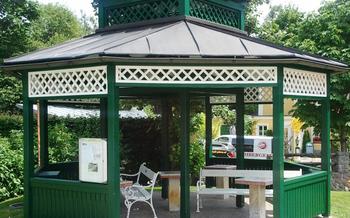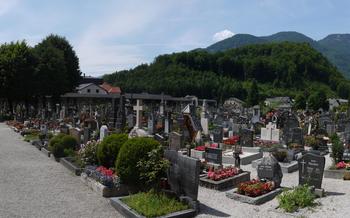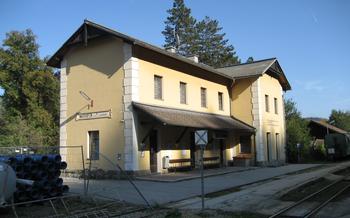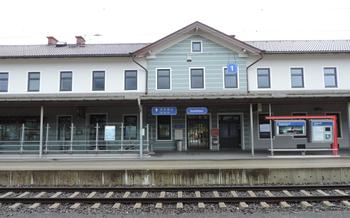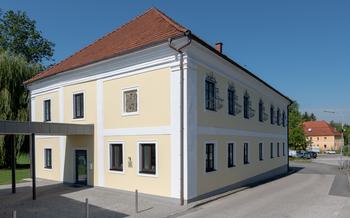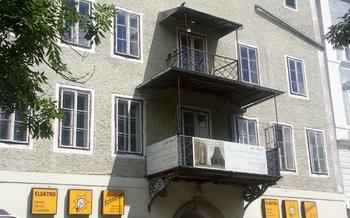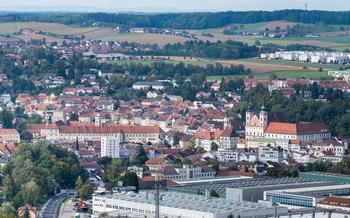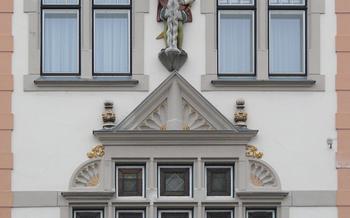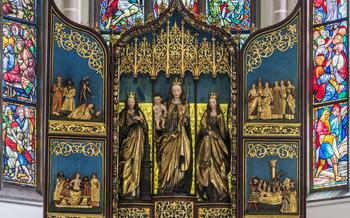
Hallstatt Salt Mine
- Hallstatt Salt Mine: A Journey Through Time
- Location and Accessibility
- Historical Overview
- Mining Techniques and Equipment
- Salt Production Process
- Natural Wonders and Geological Formations
- Cultural Heritage and Traditions
- Guided Tours and Visitor Experiences
- Safety Measures and Precautions
- Family-Friendly Activities
- Photography and Videography Guidelines
- Souvenirs and Shopping
- Dining and Refreshments
- Accessibility for Visitors with Disabilities
- Insider Tip: Secret Salt Lake
Hallstatt Salt Mine: A Journey Through Time
The Hallstatt Salt Mine, nestled in the heart of the Austrian Alps, is a remarkable subterranean treasure that offers visitors a unique journey through history, culture, and natural wonders. With a rich legacy dating back to prehistoric times, the mine has been a vital source of salt for centuries and played a pivotal role in shaping the region's economy and cultural heritage.
Step into the depths of the mine and witness the remarkable geological formations and underground chambers that have been carved out by centuries of mining activity. Explore the ancient tunnels and galleries, where miners once toiled to extract the precious salt crystals. Discover the fascinating mining techniques and equipment they employed, as well as the safety measures they implemented to protect themselves from the inherent dangers of underground mining.
Beyond its historical significance, the Hallstatt Salt Mine is also a haven for nature enthusiasts. Explore the stunning underground lakes and waterfalls, marvel at the intricate crystal formations and mineral deposits, and admire the artistic salt sculptures that adorn the mine's walls. These natural wonders create a breathtaking spectacle that is sure to leave a lasting impression.
Location and Accessibility
Situated in the Heart of the Salzkammergut Region:
The Hallstatt Salt Mine is located in the picturesque Salzkammergut region of Austria, renowned for its stunning Alpine landscapes and pristine lakes. It is situated in the idyllic village of Hallstatt, a UNESCO World Heritage Site, nestled between towering mountains and the shimmering Lake Hallstatt. The village exudes a timeless charm with its traditional wooden houses, cobblestone streets, and breathtaking panoramic views.
Transportation Options to Reach Hallstatt:
Reaching Hallstatt is a scenic journey, offering various transportation options. Visitors can take a leisurely train ride from Salzburg or Vienna, enjoying the picturesque countryside along the way. The train station is conveniently located a short walk from the village center. For those arriving by car, Hallstatt is accessible via the scenic Salzkammergut Alpine Road, offering a breathtaking driving experience. Ample parking spaces are available near the salt mine entrance.
Guided Tours Availability:
To fully immerse in the history and wonders of the Hallstatt Salt Mine, guided tours are highly recommended. Knowledgeable and passionate guides lead visitors through the labyrinthine tunnels, sharing fascinating insights into the mine's operations, cultural heritage, and geological formations. Tours are available in multiple languages, ensuring accessibility for international visitors.
Operating Hours and Ticket Prices:
The Hallstatt Salt Mine is open year-round, with varying operating hours depending on the season. It is advisable to check the official website or contact the mine directly for the most up-to-date information on hours and ticket prices. Visitors can choose from different tour options, each offering a unique perspective on the mine's rich history and natural wonders.
Historical Overview
The Hallstatt Salt Mine holds a remarkable place in history, dating back to the ancient Celtic settlement in the area. The extraction of salt, a precious resource, has been conducted since prehistoric times, leaving an indelible mark on the region's cultural and economic development. The mine's significance grew steadily, becoming a vital hub for salt production and trade. In recognition of its exceptional value, UNESCO designated Hallstatt as a World Heritage Site in 1997, further cementing its status as a historical and cultural treasure.
Mining Techniques and Equipment
Traditional mining methods employed in the Hallstatt Salt Mine have been passed down through generations, showcasing the ingenuity and resilience of the miners. The process begins with the excavation of narrow tunnels and chambers using simple tools like pickaxes and shovels. Miners worked in teams, meticulously extracting salt from the rock face, often in challenging and confined spaces.
The tools used by miners included specialized picks, hammers, wedges, and chisels. These tools were made from durable materials like iron and steel, ensuring their longevity and effectiveness in the harsh mining environment.
Safety measures were of utmost importance, given the inherent risks associated with underground mining. Miners used timber supports to reinforce the tunnels and prevent collapse. They also employed ventilation systems to circulate fresh air and remove harmful gases, ensuring a safe working environment.
Over time, mining techniques evolved with the introduction of machinery. Mechanized equipment, such as drilling machines and conveyors, increased efficiency and productivity while reducing the physical demands on the miners. However, traditional methods continued to be employed in certain areas, preserving the cultural heritage and authenticity of the mining experience.
Salt Production Process
The salt production process in the Hallstatt Salt Mine has evolved over time, but the basic principles remain the same. In the early days, miners would extract salt from underground chambers using simple tools and techniques. They would then crush the salt and mix it with water to form a brine solution. The brine was then heated and evaporated, causing the salt to crystallize. The crystals were then collected and packaged for distribution.
Today, the salt production process is much more sophisticated. Miners use modern machinery to extract the salt from the mine. The salt is then transported to a processing plant, where it is crushed and washed. The brine solution is then purified using a series of filtration and evaporation processes. Once the brine is pure, it is heated and evaporated in large vacuum pans. The salt crystals that form are then collected and dried. The dried salt is then packaged and distributed to consumers around the world.
Natural Wonders and Geological Formations
The Hallstatt Salt Mine is not only a historical and cultural treasure but also a geological wonderland. The mine unveils unique geological features that have been shaped by millions of years of salt extraction and natural processes.
-
Underground Lakes and Waterfalls: Deep within the mine, visitors can encounter mesmerizing underground lakes and waterfalls. These bodies of water have formed naturally due to the dissolution of salt and the flow of groundwater. The shimmering reflections of the lake's surface and the gentle sound of cascading waterfalls create a tranquil and awe-inspiring atmosphere.
-
Crystal Formations and Mineral Deposits: The salt mine is home to a myriad of stunning crystal formations and mineral deposits. The walls of the mine are adorned with glistening salt crystals, stalactites, and stalagmites. These formations, formed over centuries by the evaporation of salt water, showcase the intricate and delicate beauty of nature's handiwork.
-
Salt Sculptures and Artistic Creations: Throughout the mine, visitors can admire salt sculptures and artistic creations that showcase the creativity and artistry of local craftsmen. These sculptures, carved from the salt itself, depict scenes from mining history, local folklore, and mythical creatures, adding a touch of magic to the underground world.
Cultural Heritage and Traditions
The Hallstatt Salt Mine is not just a testament to the region's geological and industrial heritage but also a repository of rich cultural traditions and folklore. Over centuries, a distinct miners' culture has evolved, characterized by unique customs, rituals, and legends. The miners, known locally as Knappen, formed a close-knit community, bound together by the shared experiences of working in the dark and dangerous depths of the mine.
Folklore and legends associated with the salt mine have been passed down through generations. One popular tale tells of a kobold, a mischievous sprite said to inhabit the mine, who would sometimes play tricks on the miners. Another legend speaks of a white lady, the ghost of a miner's wife who died tragically and now haunts the mine's tunnels.
Salt has always held a special significance in the local culture and economy. The Hallstatt region has a long history of salt production, dating back to prehistoric times. Salt was a valuable commodity, used for preserving food, seasoning, and medicinal purposes. The control of salt resources brought wealth and power to the region, and the salt trade played a crucial role in the development of the local economy.
Today, the cultural heritage of the Hallstatt Salt Mine is preserved through various museums and exhibitions. The Hallstatt Salt Mine Museum showcases the history of salt mining in the region, with displays of mining tools, equipment, and artifacts. Visitors can also learn about the miners' customs and traditions, as well as the role of salt in the local economy. The Hallstatt Skywalk, a spectacular viewing platform located high above the salt mine, offers breathtaking panoramic views of the surrounding mountains and lakes, providing a unique perspective on the region's rich cultural and natural heritage.
Guided Tours and Visitor Experiences
Exploring the Depths: A Multifaceted Journey
Visitors to the Hallstatt Salt Mine can embark on an array of guided tours, each tailored to offer a unique perspective on the mine's history, geology, and cultural heritage. These tours provide an immersive and educational experience, allowing visitors to delve into the depths of the mine and uncover its hidden wonders.
Standard Tour: Unveiling the Salt Mine's Secrets
The standard tour is an excellent introduction to the Hallstatt Salt Mine. Led by knowledgeable guides, visitors are taken through the mine's main galleries and chambers, where they can witness the impressive salt formations, learn about the mining techniques used throughout history, and discover the cultural significance of salt in the region.
Adventure Tour: Delving into the Unknown
For those seeking a more thrilling experience, the adventure tour offers an in-depth exploration of the mine's lesser-known areas. Visitors are equipped with protective gear and embark on a journey through narrow tunnels, past underground lakes, and into hidden chambers, gaining an insider's perspective on the challenges faced by miners in the past.
Family Tour: Engaging the Young Explorers
Families with children can opt for the family tour, which is designed to engage and entertain younger visitors. Interactive exhibits, hands-on activities, and storytelling elements bring the mine's history to life, making learning fun and exciting for kids of all ages.
Tailoring the Experience: Duration and Difficulty Levels
Guided tours vary in duration and difficulty level, catering to different interests and abilities. The standard tour lasts approximately 75 minutes and is suitable for visitors of all fitness levels. The adventure tour, with its more challenging terrain, is recommended for physically fit individuals and lasts for about two hours.
Storytelling and Education: Bringing the Mine to Life
Throughout the tours, guides captivate visitors with captivating stories of the miners' lives, the cultural significance of salt, and the geological wonders of the mine. Educational panels and interactive displays further enhance the learning experience, providing visitors with a deeper understanding of the mine's history and its impact on the region.
Safety Measures and Precautions
Visiting the Hallstatt Salt Mine involves certain safety regulations and precautions to ensure the well-being of all visitors. Adhering to these guidelines is essential for a safe and enjoyable experience.
-
Safety Equipment: Upon entering the salt mine, visitors are provided with protective clothing, including sturdy overalls, helmets, and lamps. These are mandatory safety gear that must be worn throughout the tour.
-
Health and Fitness: While the mine is accessible to most visitors, it's essential to consider one's health and fitness level. The tour involves walking on uneven surfaces, climbing stairs, and navigating narrow passages. Participants with heart conditions or mobility issues should consult with their doctor before embarking on the tour.
-
Emergency Preparedness: The salt mine is equipped with emergency exits and evacuation routes that are clearly marked throughout the tour. Visitors are advised to familiarize themselves with these exits and follow the instructions provided by the tour guides in case of an emergency.
-
Children and Supervision: Children under the age of 4 are not permitted in the mine due to safety concerns. Children between the ages of 4 and 14 must be accompanied by an adult at all times. Parents or guardians are responsible for ensuring the safety and proper behavior of their children during the tour.
-
Prohibited Items: Sharp objects, flammable materials, and large backpacks are not allowed inside the mine for safety reasons. Visitors are requested to leave these items in their vehicles or at the cloakroom provided at the entrance.
Family-Friendly Activities
Visiting the Hallstatt Salt Mine can be an enriching and enjoyable experience for families with children. The mine offers a range of attractions specifically designed to cater to young visitors and make their visit both educational and entertaining.
Special Tours for Families: The mine offers guided tours tailored specifically for families, taking into account the interests and learning abilities of children. These tours often include interactive elements, storytelling, and hands-on activities that make the history and science of salt mining come alive for kids.
Interactive Exhibits and Hands-On Activities: Throughout the mine, visitors can find interactive exhibits that allow children to engage with the mining process in a fun and hands-on way. They can learn about salt production, explore geological formations, and even try their hand at panning for salt.
Children's Play Areas and Educational Programs: To keep younger children entertained, the mine features designated play areas with educational games and activities related to salt mining. There are also educational programs designed for school groups, which provide a deeper dive into the history, geology, and cultural significance of the mine.
Family Discounts and Packages: To make the experience more affordable for families, the mine offers discounted rates for children and special family packages that include admission tickets, guided tours, and souvenirs. These packages are designed to provide a comprehensive and budget-friendly experience for families visiting the Hallstatt Salt Mine.
Photography and Videography Guidelines
Capturing the mesmerizing beauty of the Hallstatt Salt Mine through photography or videography is an enriching experience. However, to ensure a harmonious and respectful visit for all, certain guidelines must be adhered to.
Permitted and Restricted Areas: - Photography and videography are generally permitted within the salt mine, except in designated restricted areas. These areas may include sections where mining operations are still active or where the preservation of cultural artifacts is paramount.
Use of Flash Photography and Tripods: - The use of flash photography is prohibited within the salt mine to prevent damage to the delicate salt formations and cultural heritage. Tripods are also not allowed as they can obstruct the walkways and hinder the movement of other visitors.
Professional Photography Requirements: - Professional photographers and videographers who wish to use the salt mine as a backdrop for commercial purposes must obtain prior permission from the mine's management. Terms and conditions may apply, and fees may be charged.
Respecting the Privacy of Other Visitors: - Visitors should be mindful of other guests' privacy when taking photographs or recording videos. It is important to refrain from capturing images or footage that may be intrusive or disrespectful.
Souvenirs and Shopping
Treasure Trove of Mementos
Gift Shops Galore: Emerge from the subterranean realm of the Hallstatt Salt Mine with cherished memories and tangible souvenirs. Within the mine's depths, you'll find a treasure trove of gift shops brimming with unique mementos to commemorate your visit.
Salt Souvenirs: Of course, no trip to a salt mine is complete without taking home a piece of the prized mineral itself. Choose from a variety of salt products, including gourmet salts, bath salts, and decorative salt lamps. These make thoughtful gifts for friends and family who appreciate the finer things in life.
Local Crafts and Delicacies: Support local artisans and savor the flavors of the region by purchasing handcrafted souvenirs and regional specialties. From intricately carved wooden figurines to mouthwatering chocolates and pastries, there's something for every taste and budget.
Duty-Free Delights: Take advantage of the duty-free shopping opportunities available at the Hallstatt Salt Mine. Indulge in luxury items such as perfumes, cosmetics, and fine spirits without the added cost of taxes.
Dining and Refreshments
Café-Restaurant Salzwelten
After exploring the depths of the salt mine, you can satisfy your appetite at the on-site restaurant, Café-Restaurant Salzwelten. This cozy and charming restaurant offers a delightful menu featuring traditional Austrian cuisine and local specialties. Indulge in hearty dishes such as Wiener Schnitzel, Käsespätzle (cheese spaetzle), or Tafelspitz (boiled beef). For a lighter meal, opt for a refreshing salad or a tempting sandwich.
The restaurant also serves a variety of beverages, including refreshing juices, local beers, and Austrian wines. You can enjoy your meal indoors, surrounded by the rustic ambiance of the salt mine, or bask in the warm sunlight on the outdoor terrace, offering stunning views of the surrounding mountains.
Picnic Areas
If you prefer to embrace the outdoors and enjoy a picnic-style lunch, several designated picnic areas are located within the vicinity of the salt mine. These areas offer scenic views and provide a tranquil setting for a relaxing break. You can bring your own packed lunch or purchase snacks and drinks from the vending machines or snack bars located within the salt mine.
Vending Machines and Snack Bars
For those who prefer a quick bite or a refreshing drink, vending machines and snack bars are conveniently located throughout the salt mine. These vending machines offer a variety of snacks, beverages, and confectionery items to satisfy your cravings.
Accessibility for Visitors with Disabilities
The Hallstatt Salt Mine is committed to ensuring an inclusive and accessible experience for all visitors, regardless of physical limitations. A range of accessibility features and services are available to make the mine accessible to visitors with disabilities.
Wheelchairs and strollers can easily navigate the well-maintained paths and ramps throughout the mine. Visitors with hearing impairments can take advantage of the audio guides that provide detailed descriptions of the mine's history, geology, and mining techniques. These guides are available in multiple languages and can be used with personal headphones or provided headsets.
For visitors with visual impairments, Braille signage is placed strategically throughout the mine, providing tactile information about the various exhibits and points of interest. Additionally, tactile exhibits allow visitors to explore the textures and shapes of salt formations and mining equipment.
Trained staff is always available to assist visitors with disabilities, providing guidance and assistance as needed. They can help with wheelchair access, provide information in sign language, or arrange for additional support if required.
With these accessibility features and services in place, the Hallstatt Salt Mine welcomes visitors of all abilities to embark on a fascinating journey through the depths of this historic and awe-inspiring underground world.
Insider Tip: Secret Salt Lake
Hidden deep within the Hallstatt Salt Mine lies a secret and mesmerizing natural wonder—the Secret Salt Lake. Discovered during mining operations, this subterranean lake is a true hidden gem that offers an unforgettable experience for adventurous visitors.
Accessible only through a special guided tour, the Secret Salt Lake tour takes you on a journey through narrow tunnels and across wooden bridges, revealing the stunning beauty of this hidden oasis. As you descend into the mine, the air becomes cool and humid, and the sound of dripping water echoes through the tunnels.
The lake itself is a sight to behold. Its crystal-clear waters reflect the shimmering salt crystals that line the walls, creating a magical and ethereal atmosphere. The lake is surrounded by stalactites and stalagmites, which have been formed over thousands of years by the evaporation of salt water.
The Secret Salt Lake tour is a unique opportunity to explore a hidden part of the Hallstatt Salt Mine and to witness the natural wonders that lie beneath the surface. With its limited availability and advance booking required, this tour is a must-do for anyone seeking an unforgettable and awe-inspiring experience.

